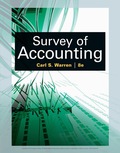
Survey of Accounting (Accounting I)
8th Edition
ISBN: 9781337517386
Author: WARREN
Publisher: Cengage
expand_more
expand_more
format_list_bulleted
Concept explainers
Textbook Question
Chapter 12, Problem 12.4.1MBA
Contribution margin per constraint Using the data and your answers from MBA 12-2, determine the following:
The selling price necessary for Laminated glass to be as profitahle as Regular glass.
Expert Solution & Answer
Want to see the full answer?
Check out a sample textbook solution
Students have asked these similar questions
Financial accounting
Dont use ai solution general Accounting question
Need correct answer general Accounting
Chapter 12 Solutions
Survey of Accounting (Accounting I)
Ch. 12 - Mario Company is considering discontinuing a...Ch. 12 - Victor Company is considering disposing of...Ch. 12 - Prob. 3SEQCh. 12 - For which cost concept used in applying (he...Ch. 12 - Prob. 5SEQCh. 12 - Prob. 1CDQCh. 12 - Prob. 2CDQCh. 12 - A company could sell a building for $650,000 or...Ch. 12 - Prob. 4CDQCh. 12 - Prob. 5CDQ
Ch. 12 - A company fabricates a component at a cost of...Ch. 12 - Prob. 7CDQCh. 12 - Prob. 8CDQCh. 12 - Prob. 9CDQCh. 12 - Prob. 10CDQCh. 12 - Prob. 11CDQCh. 12 - Prob. 12CDQCh. 12 - Lease or sell decision Orwell Industries is...Ch. 12 - Prob. 12.2ECh. 12 - Prob. 12.3ECh. 12 - Prob. 12.4ECh. 12 - Prob. 12.5ECh. 12 - Make-or-buy decision Watts Technologies Company...Ch. 12 - Make-or-buy decision Wisconsin Arts of Milwaukee...Ch. 12 - Machine replacement decision Creekside Products...Ch. 12 - Differential analysis report for machine...Ch. 12 - Sell or process further St. Paul Lumber Company...Ch. 12 - Prob. 12.11ECh. 12 - Decision on accepting additional business Madison...Ch. 12 - Accepting business at a special price Palomar...Ch. 12 - Prob. 12.14ECh. 12 - Total cost concept of product costing Willis...Ch. 12 - Product cost concept of product pricing Based on...Ch. 12 - Variable cost concept of product pricing Based on...Ch. 12 - Target costing Toyota Motor Corporation (TM) uses...Ch. 12 - Differential analysis report involving opportunity...Ch. 12 - Prob. 12.1.2PCh. 12 - Prob. 12.1.3PCh. 12 - Differential analysis report for machine...Ch. 12 - Differential analysis report for machine...Ch. 12 - Differential analysis report for sales promotion...Ch. 12 - Differential analysis report for sales promotion...Ch. 12 - Differential analysis report for further...Ch. 12 - Prob. 12.4.2PCh. 12 - Product pricing using the cost-plus approach...Ch. 12 - Prob. 12.5.2PCh. 12 - Prob. 12.5.3PCh. 12 - Product pricing using the cost-plus approach...Ch. 12 - Prob. 12.5.5PCh. 12 - Product pricing using the cost-plus approach...Ch. 12 - Prob. 12.1MBACh. 12 - Prob. 12.2MBACh. 12 - Prob. 12.3.1MBACh. 12 - Contribution margin per constraint Using the data...Ch. 12 - Prob. 12.3.3MBACh. 12 - Contribution margin per constraint Using the data...Ch. 12 - Prob. 12.4.2MBACh. 12 - Contribution margin per constraint Using the data...Ch. 12 - Prob. 12.5.1MBACh. 12 - Prob. 12.5.2MBACh. 12 - Prob. 12.5.3MBACh. 12 - Product pricing Bev Frazier is a cost accountant...Ch. 12 - Prob. 12.2CCh. 12 - Prob. 12.3CCh. 12 - Cost-plus and target costing concepts The...Ch. 12 - Cost-plus and target costing concepts The...
Knowledge Booster
Learn more about
Need a deep-dive on the concept behind this application? Look no further. Learn more about this topic, accounting and related others by exploring similar questions and additional content below.Similar questions
- Year 0123 Cash Flow -$ 19,000 11,300 10,200 6,700 a. What is the profitability index for the set of cash flows if the relevant discount rate is 11 percent? Note: Do not round intermediate calculations and round your answer to 3 decimal places, e.g., 32.161. b. What is the profitability index for the set of cash flows if the relevant discount rate is 16 percent? Note: Do not round intermediate calculations and round your answer to 3 decimal places, e.g., 32.161. c. What is the profitability index for the set of cash flows if the relevant discount rate is 23 percent? Note: Do not round intermediate calculations and round your answer to 3 decimal places, e.g., 32.161. a. Profitability index b. Profitability index c. Profitability indexarrow_forwardSol This question answerarrow_forwardRecently, Abercrombie & Fitch has been implementing a turnaround strategy since its sales had been falling for the past few years (11% decrease in 2014, 8% in 2015, and just 3% in 2016.) One part of Abercrombie's new strategy has been to abandon its logo-adorned merchandise, replacing it with a subtler look. Abercrombie wrote down $20.6 million of inventory, including logo-adorned merchandise, during the year ending January 30, 2016. Some of this inventory dated back to late 2013. The write-down was net of the amount it would be able to recover selling the inventory at a discount. The write-down is significant; Abercrombie's reported net income after this write-down was $35.6 million. Interestingly, Abercrombie excluded the inventory write-down from its non-GAAP income measures presented to investors; GAAP earnings were also included in the same report. Question: What is the impact on Abercrombie & Fitch's financial statements from the write-down of its logo-adorned merchandise…arrow_forward
arrow_back_ios
SEE MORE QUESTIONS
arrow_forward_ios
Recommended textbooks for you
 Survey of Accounting (Accounting I)AccountingISBN:9781305961883Author:Carl WarrenPublisher:Cengage Learning
Survey of Accounting (Accounting I)AccountingISBN:9781305961883Author:Carl WarrenPublisher:Cengage Learning Principles of Cost AccountingAccountingISBN:9781305087408Author:Edward J. Vanderbeck, Maria R. MitchellPublisher:Cengage Learning
Principles of Cost AccountingAccountingISBN:9781305087408Author:Edward J. Vanderbeck, Maria R. MitchellPublisher:Cengage Learning Managerial Accounting: The Cornerstone of Busines...AccountingISBN:9781337115773Author:Maryanne M. Mowen, Don R. Hansen, Dan L. HeitgerPublisher:Cengage Learning
Managerial Accounting: The Cornerstone of Busines...AccountingISBN:9781337115773Author:Maryanne M. Mowen, Don R. Hansen, Dan L. HeitgerPublisher:Cengage Learning Cornerstones of Cost Management (Cornerstones Ser...AccountingISBN:9781305970663Author:Don R. Hansen, Maryanne M. MowenPublisher:Cengage Learning
Cornerstones of Cost Management (Cornerstones Ser...AccountingISBN:9781305970663Author:Don R. Hansen, Maryanne M. MowenPublisher:Cengage Learning

Survey of Accounting (Accounting I)
Accounting
ISBN:9781305961883
Author:Carl Warren
Publisher:Cengage Learning

Principles of Cost Accounting
Accounting
ISBN:9781305087408
Author:Edward J. Vanderbeck, Maria R. Mitchell
Publisher:Cengage Learning

Managerial Accounting: The Cornerstone of Busines...
Accounting
ISBN:9781337115773
Author:Maryanne M. Mowen, Don R. Hansen, Dan L. Heitger
Publisher:Cengage Learning

Cornerstones of Cost Management (Cornerstones Ser...
Accounting
ISBN:9781305970663
Author:Don R. Hansen, Maryanne M. Mowen
Publisher:Cengage Learning
What is variance analysis?; Author: Corporate finance institute;https://www.youtube.com/watch?v=SMTa1lZu7Qw;License: Standard YouTube License, CC-BY